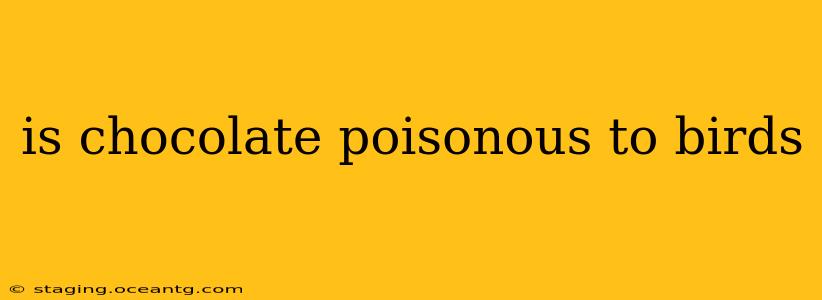Chocolate, a beloved treat for humans, poses a significant threat to birds. The answer, simply put, is yes, chocolate is poisonous to birds. This isn't just a mild inconvenience; it can be life-threatening. The toxicity stems from theobromine, a compound found in cacao beans that's a stimulant for birds – far more so than for humans. Unlike humans, birds lack the efficient metabolic enzymes to process theobromine, leading to a buildup of toxins in their systems. This can result in severe illness and even death.
What Makes Chocolate Toxic to Birds?
The primary culprit is theobromine, a methylxanthine alkaloid. The concentration of theobromine varies depending on the type of chocolate. Dark chocolate, with its higher cacao content, contains the highest concentration and is therefore the most dangerous. Milk chocolate and white chocolate have lower levels, but they are still toxic and should never be given to birds.
The severity of the poisoning depends on several factors, including:
- Type of chocolate: Dark chocolate is the most dangerous, followed by milk chocolate, and then white chocolate.
- Amount consumed: Even small amounts of dark chocolate can be harmful to small birds.
- Size of the bird: Smaller birds are more susceptible to the effects of theobromine than larger birds.
What are the Symptoms of Chocolate Poisoning in Birds?
If your bird ingests chocolate, watch for these symptoms:
- Increased thirst and urination: Theobromine acts as a diuretic.
- Vomiting and diarrhea: The bird's body attempts to expel the toxin.
- Restlessness and hyperactivity: Initially, theobromine can cause a stimulant effect.
- Tremors and seizures: As the toxin builds up, neurological symptoms appear.
- Increased heart rate: Theobromine can affect the cardiovascular system.
- Difficulty breathing: In severe cases, respiratory distress can occur.
- Lethargy and weakness: As the poisoning progresses, the bird may become weak and unresponsive.
- Death: In severe cases, chocolate poisoning can be fatal.
What Should I Do If My Bird Eats Chocolate?
Immediate action is crucial if you suspect your bird has ingested chocolate. Contact your avian veterinarian immediately. Time is of the essence, and early intervention significantly improves the chances of successful treatment. The vet may induce vomiting or administer other treatments to help your bird eliminate the toxin.
How Much Chocolate is Too Much for a Bird?
There's no safe amount of chocolate for birds. Even the smallest amount can be harmful. It's best to keep all chocolate products out of reach of your feathered friends.
What Other Foods Are Toxic to Birds?
Besides chocolate, several other foods are toxic to birds. These include:
- Avocado: Contains persin, which can cause vomiting and diarrhea.
- Caffeine: Found in coffee, tea, and soda, it can cause similar symptoms to chocolate poisoning.
- Alcohol: Highly toxic and can be fatal.
- Onions and garlic: Can damage red blood cells.
- Salt: Excessive salt intake can be fatal.
- Raw beans: Contain toxins that can cause illness.
- Xylitol: A sugar substitute found in some foods, can cause a dangerous drop in blood sugar.
How Can I Prevent My Bird from Eating Chocolate?
Prevention is always the best approach:
- Store chocolate securely: Keep all chocolate out of reach of your bird, ideally in sealed containers in a cupboard.
- Be mindful of discarded wrappers: Dispose of chocolate wrappers promptly and thoroughly.
- Educate family members: Ensure everyone in your household knows the dangers of chocolate for birds.
- Supervise interactions: Always supervise your bird when it's around people who might accidentally offer it food.
Remember, your bird's health and safety are paramount. By understanding the dangers of chocolate and taking preventative measures, you can ensure your feathered friend enjoys a long and healthy life.
